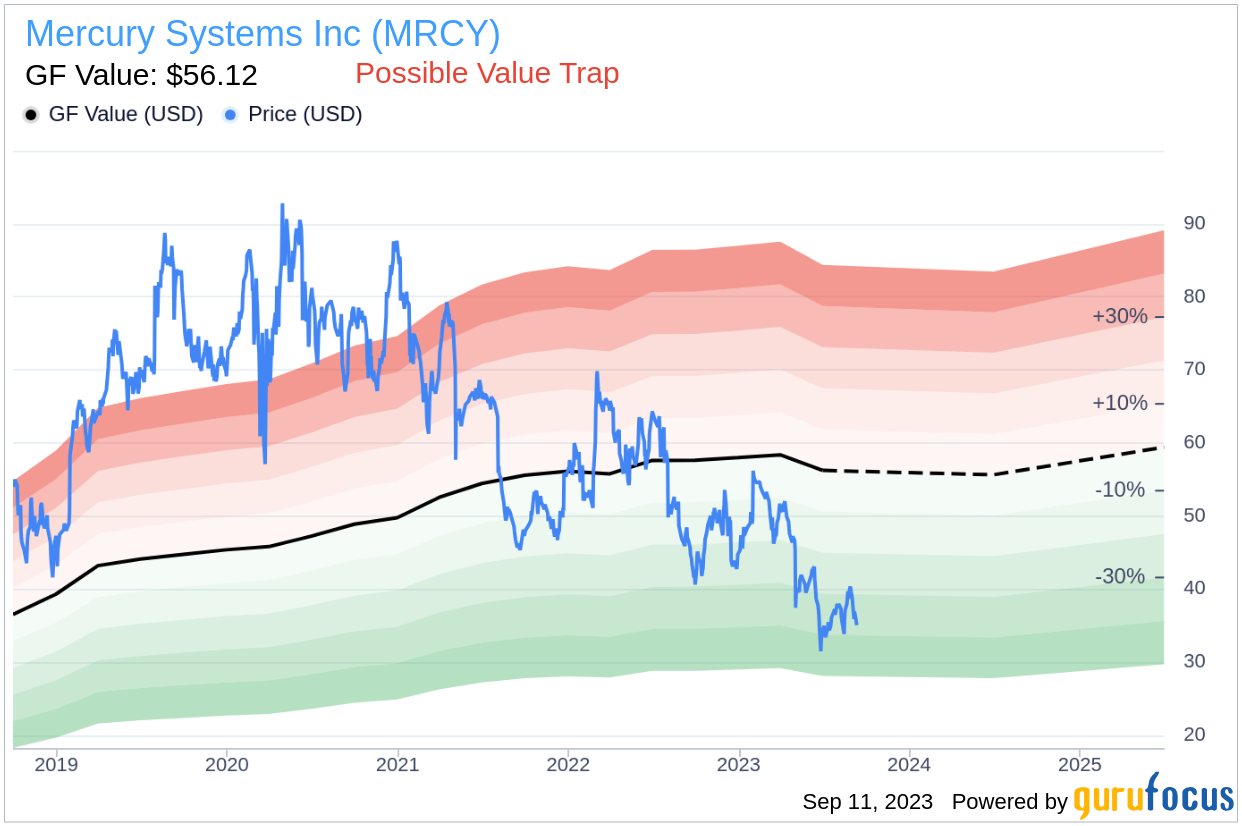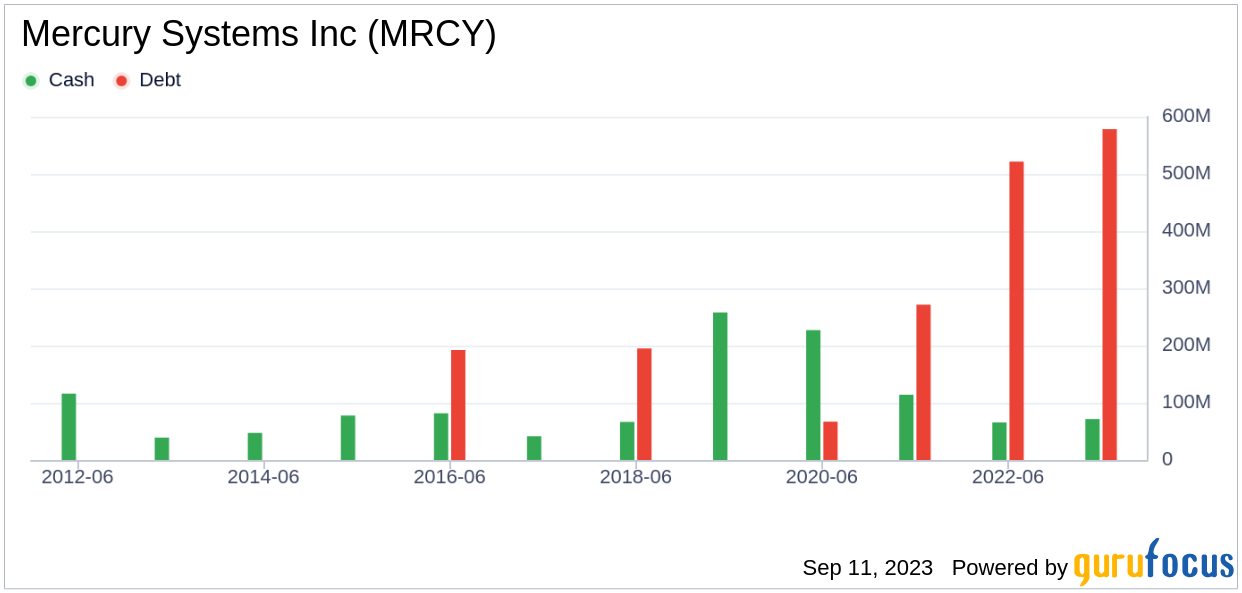Value-focused investors are always on the hunt for stocks that are priced below their intrinsic value. One such stock that merits attention is Mercury Systems Inc (MRCY, Financial). The stock, which is currently priced at 35.06, recorded a loss of 3.46% in a day and a 3-month decrease of 17.84%. The stock's fair valuation is $56.12, as indicated by its GF Value.
Understanding GF Value
The GF Value represents the current intrinsic value of a stock derived from our exclusive method. It is calculated based on three factors: historical multiples that the stock has traded at, GuruFocus adjustment factor based on the company's past returns and growth, and future estimates of the business performance. We believe the GF Value Line is the fair value that the stock should be traded at.
However, investors need to consider a more in-depth analysis before making an investment decision. Despite its seemingly attractive valuation, certain risk factors associated with Mercury Systems should not be ignored. These risks are primarily reflected through its low Piotroski F-score of 1. These indicators suggest that Mercury Systems, despite its apparent undervaluation, might be a potential value trap. This complexity underlines the importance of thorough due diligence in investment decision-making.
Deciphering the Piotroski F-score
The Piotroski F-score, created by accounting professor Joseph Piotroski, is a tool used to assess the strength of a company's financial health. The score is based on nine criteria that fall into three categories: profitability, leverage/liquidity/ source of funds, and operating efficiency. The overall score ranges from 0 to 9, with higher scores indicating healthier financials. Mercury Systems's current Piotroski F-Score, however, falls in the lower end of this spectrum, indicating potential red flags for investors.
Company Overview
Mercury Systems Inc is a commercial technology company serving the aerospace and defense industry. The company envisions, creates and delivers secure open architecture solutions powering a broad range of mission-critical applications in challenging and demanding environments. Despite its operational strengths, the company's financial indicators suggest potential risks. The company's stock price, compared to its GF Value, may initially seem undervalued. However, a deeper analysis reveals potential concerns that investors should consider.
Analysis of Mercury Systems's' Profitability
One significant component of the F-Score is a positive return on assets (ROA). A closer look at Mercury Systems's ROA reveals a worrying trend of negative returns. This indicates the company's inability to generate profit from its assets - a fundamental concern for any investor.
Let's delve deeper into Mercury Systems's financial health by examining the decline in its return on assets (ROA) over the past three years. The data indicates 2021: 3.42; 2022: 0.53; 2023: -1.20, when expressed in percentages. Such a decrease is concerning, as the Piotroski F-Score penalizes companies with lower current ROA compared to the previous period. This ongoing decline highlights another potential risk associated with investing in Mercury Systems.
Leverage, Liquidity and Source of Funds: A Worrying Trend
Assessing the aspect of leverage, liquidity, and sources of funds, Mercury Systems demonstrates an alarming rise in its debt-to-total assets ratio over the past three years. The provided data shows 2021: 0.14; 2022: 0.23; 2023: 0.24, expressed as percentages. A higher debt ratio suggests that Mercury Systems is increasingly financing its assets through debt, thereby escalating its financial risk. The Piotroski F-Score views this as a negative indicator, further cautioning investors about Mercury Systems.
Examining Mercury Systems's financial stability, there's a notable decrease in its current ratio over the past three years, as shown by the data 2021: 4.26; 2022: 4.20; 2023: 4.02, which is expressed as percentages. The current ratio is a key indicator of a company's short-term financial health, as it gauges the ability to cover short-term liabilities with short-term assets. A declining current ratio suggests that Mercury Systems's liquidity and capability to manage immediate financial obligations are deteriorating.
Operating Efficiency: A Darker Picture
Examining the data provided: 2021: 55.59; 2022: 57.12; 2023: 57.29, it becomes evident that Mercury Systems has seen an increase in its Diluted Average Shares Outstanding over the past three years. This trend signals that the company has issued more shares. While issuing additional shares can provide immediate capital for the business, it can also lead to the dilution of existing shares' value.
Lastly, concerning operating efficiency, the Piotroski F-score examines changes in gross margin and asset turnover. Regrettably, Mercury Systems follows a discouraging trajectory with a decrease in gross margin percentage over the past three years, as demonstrated by the data provided: 2021: 41.69; 2022: 39.97; 2023: 32.52 (expressed in percentages). This contraction in gross margin suggests that Mercury Systems is grappling with either an escalation in the cost of goods sold or dwindling prices - both of which are inauspicious indicators for profitability.
In terms of operational efficiency, another key indicator, Mercury Systems has unfortunately reported a declining trend in asset turnover over the past three years, as evidenced by the data: 2021: 0.51; 2022: 0.46; 2023: 0.41 (expressed in percentages). Asset turnover measures how effectively a company uses its assets to generate sales, and a decrease in this ratio can indicate a drop in efficiency.
Conclusion
While the Piotroski F-score is not the only lens through which to view a potential investment, it is a robust and comprehensive tool for evaluating a company's financial health. Unfortunately for Mercury Systems, its current score suggests potential troubles. Despite its seemingly undervalued price, the stock's low Piotroski F-score and declining financial indicators suggest it could be a potential value trap. Investors should exercise caution and conduct thorough due diligence before considering an investment in Mercury Systems.
GuruFocus Premium members can find stocks with high Piotroski F-score using the following Screener: Piotroski F-score screener .



